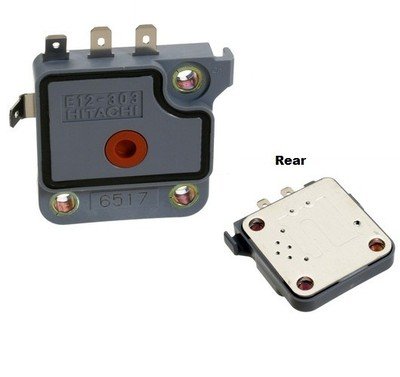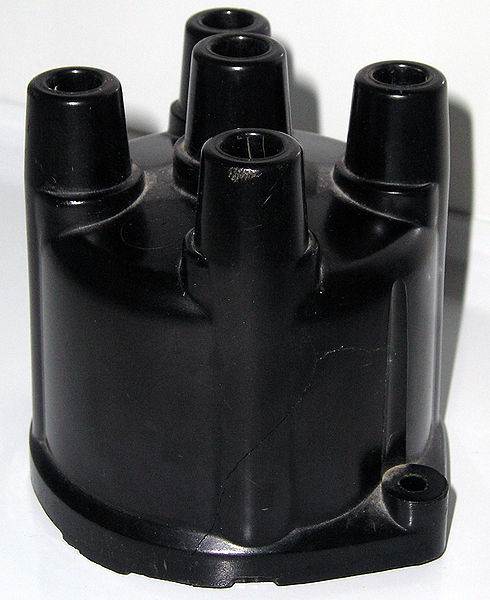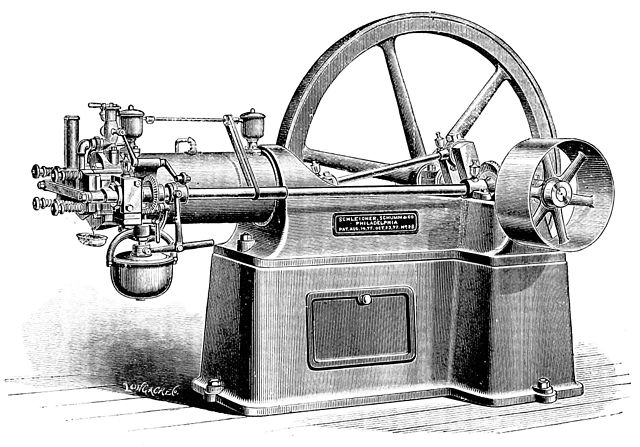Stuck in Park: Why Your Car Won’t Go Into Gear
Question: Why Won’t My Car Go into Gear?
My car drove fine yesterday on the way home, but now I’m stuck. It starts up, but I can’t go anywhere because the car is stuck in park for some reason. I can’t even shift into reverse, let alone drive, so I ended up just taking the bus. Am I going to have to get the car towed (can they even tow it like this?), or is there a way to get a car into gear when it’s stuck in park?
Answer
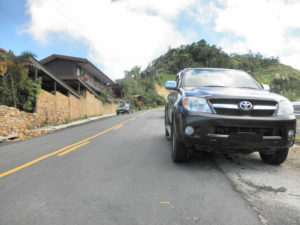
When you park on an incline without a parking brake, you may find that you can’t shift out of park. [Image courtesy Jason Thien, via Flickr (Creative Commons 2.0)
On the less dire side of the spectrum, your issue could have to do with the manual shift lock override, if your car has one, a bad brake light switch, or even your ignition switch. Some of these are more complicated to deal with than others, but they’re all things you can check before you call for a tow.
- Is your car parked on an incline?
- When a car is parked on a hill, excessive pressure on the park pawl may prevent it from retracting.
- Pushing the car even an inch or two is usually enough to relieve pressure.
- To avoid this problem in the future, apply your parking brake before you take your foot off the brake and shift into park.
- Do your brake lights work?
- The brake switch is often tied into the shift interlock mechanism.
- Have someone stand behind your car and check your brake light operation.
- If the brake lights don’t turn on when you push on the brake, check the brake switch to make sure it’s plugged in and operating correctly.
- Does your car have a manual shift interlock release?
- Check around your shifter for a button, key slot, or plug.
- If you find a plug, removing it may reveal a slot to insert a key.
- Pushing the shift interlock button or inserting a key into the slot should allow you to shift out of park, but make sure to apply the brakes first.
- If your shifter has a button on the knob you always have to push to shift out of park, a problem with this button will also prevent you from shifting into gear.
What to Do When Your Car Won’t Shift Out of Park
There’s always a chance that you will have to call a tow truck, or a mobile mechanic, to get your car back in gear. But before you do that, there are a few things that you can check yourself:
What Causes a Car to Get Stuck in Gear?
When you shut your car off and shift it into park, you’ve probably noticed that your car seems rooted in place. Whether parked on the flat or an incline, a car in park will resist any movement either forward or back. This is because shifting into park causes something called a park pawl to engage with a parking gear located inside your transmission.
The physical contact between the parking pawl and the park gear is what actually causes the transmission to “be in park,” so the literal reason that your car won’t shift out of park is often because something is preventing the pawl from disengaging with the gear.
The Problem With Parking Pawls
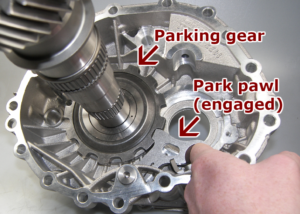
Letting the weight of a car rest on a parking pawl can result in a jam, and you won’t be able to shift out of park.
The whole point of a parking pawl is to prevent a car from accidentally rolling away if you forget to apply your emergency brake. However, the emergency brake is still intended to remain the primary method of holding your car in place any time you park on an incline.
While a parking pawl is technically capable of holding your car in place even on a very steep incline, relying on it without applying the parking brake comes with a host of potential problems. In a worst case scenario, putting the entire weight of your vehicle on the pawl repeatedly can eventually cause something to give way and break.
In terms of a car that won’t shift out of park, the pawl can also be to blame. When you release your brake on a hill without setting the parking brake, you will notice your car slide backward a little bit before it clunks to a stop. This is the parking gear rotating with your wheels until it comes solidly into contact with the pawl.
In most cases, you’ll still be able to shift out of park, even if you do forget to set your parking brake. However, putting the entire weight of your car on the pawl can jam it in place so hard that you won’t be able to shift at all.
What to Do When a Parking Pawl Gets Stuck
Although it may be tempting to just apply more force to try and convince the pawl to move, this is generally a very bad idea. Your shifter isn’t tied directly to the pawl, so applying more pressure to the one doesn’t necessarily mean you’re applying more pressure to the other. And even if you were, doing so would be more likely to break something new than to fix the problem you already have.
Dealing with a jammed parking pawl is usually just a matter of relieving the pressure, which can be accomplished by pushing the car up the incline a little. The safest way to do this is with your strongest friends behind the car, while someone sits in the driver’s seat ready to act.
As soon as the shifter moves freely, the person in the driver’s seat should firmly apply the brake and the parking brake. The vehicle can then be safely started, and you should be able to shift out of park as you normally would.
If the incline is too great, then you may be able to remove pressure from the pawl by pushing the vehicle with another vehicle, although doing so can be very dangerous if you do it wrong. You can also have a tow truck pull the vehicle forward, or lift the drive wheels off the ground.
Jacking the drive wheels off the ground should also remove pressure from the pawl, although you need to be careful to block the other wheels to prevent the vehicle from moving. You should also be ready to apply the brakes as soon as the vehicle is shifted out of park, so this job is safest if you have one person to jack the car up while a second person remains in the car to apply the brakes.
How Your Brake Switch Can Keep You From Shifting
Shift interlock systems are typically designed to prevent you from shifting out of park without depressing the brake pedal, and the easiest way to accomplish that is by tying into the same switch that activates the brake light.
When a brake light switch gets accidentally disconnected, wears out, or breaks, it can prevent the shift interlock system from working properly. The easiest way to check whether this is happening to you is is to depress the brake pedal and verify that the brake lights come on. If the brake lights do turn on, then your problem probably isn’t the brake light switch.
Brake light switches are usually located on, or in the vicinity of, the brake pedal. If you are able to locate a switch that is activated by the brake pedal, that’s probably going to be your brake switch.
Testing a brake light switch is a little more complicated than finding one, but it’s pretty easy to at least verify that it’s plugged in. If it isn’t, then you can locate the plug, reconnect it, and see if that fixes the problem.
You can also use a multimeter to see if the resistance of the switch changes when you push the brake pedal. If the circuit remains open no matter what, or it always shows continuity and the resistance doesn’t change, that’s a sign that the switch may be broken or worn out, or it could be out of adjustment.
Dealing With Manual Shift Interlock Releases
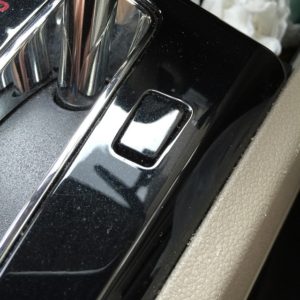
Look for a button, cap, or plug around your console-mounted shifter to find an interlock override. [Image courtestyChris Doelle, via Flickr (Creative Commons 2.0)]
Some console-mounted shifters have buttons located right next to the shifter that you can push if the interlock isn’t working right. Others have a slot that you can insert a key into, while another design involves a small plug in the vicinity of the shifter that you can remove to reveal a slot.
Many column-mounted shifters also have manual overrides, but they can be harder to find. So if you don’t have access to your owner’s manual, you should look on the top, bottom and sides of the column shroud for a plug or a slot, which you should be able to stick a key into to override the shift interlock.
Another way to override the shift interlock in some vehicles involves turning the ignition key to the first position, which will be between the off and start positions. You will then find it possible to shift out of park, although it’s very important to make sure you activate your brakes first.
When to Call Your Mechanic for Shifting Problems
While there are a lot of reasons for a car to get stuck in park that you can deal with yourself, there’s always a chance that you’re dealing with a more serious problem. So if you check everything mentioned above, and you still can’t shift out of park, then you’re probably looking at a visit to your mechanic.



